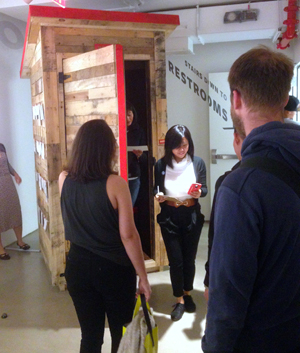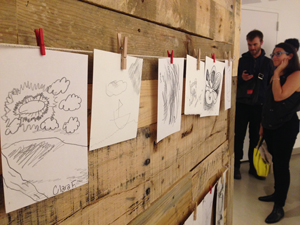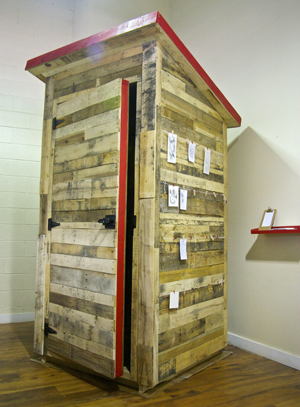On Site | InsideOUT House
1. Overview
Inside Out House is a binaural audio installation in the form of a wooden outhouse, embedded with sounds recorded in woodland and quiet agricultural landscapes (gardens, fields, etc). Using simulated blindness to enhance the aural sense, the project explores the human need for “involuntary” or effortless attention and aims to mimic the restorative experience of being outside in nature using auditory stimuli. While in the darkened structure, viewers are invited to visualize their experience by creating a drawing, which they may then contribute to the installation.
Binaural recordings give the effect of hearing sound in three-dimensional space and provide a unique sensory “reality.” This experience challenges the viewer to: surrender to the auditory sense, conjure a feeling of solitude rarely encountered in the urban environment, and visualize their experience through drawing.
Example Binaural Audio Used:
Participatory Component:
Visitors will have the opportunity to contribute a “sound drawing,” which will be hung on a nearby wall or on the structure itself. These raw, experimental documents, created by participants while inside the darkened InsideOut House, will represent the collective experiences of visitors.
The aim of this component is to challenge viewers to connect their aural sense to the responsive, tactile act of drawing (or “seeing” and documenting the experience of hearing a natural soundscape).
Stimulating an aural connection to nature in combination with the cognitive shift of documenting this experience through drawing is an experiment aimed at discovering how these sensory connections or deprivations affect us.
NOTE: Drawing could be considered a “directed” or “voluntary activity” (see below), but without sight, it becomes increasingly involuntary - less focused on a result and more about the process or act of mediation.
2. Project Design and Research
Evolutionary Biologist E.O. Wilson coined the term ‘biophilia’: ‘the innate tendency to affiliate with other living creatures and processes’. (Wilson, Edward O. (1984). Biophilia. Cambridge: Harvard University Press)
When I am unable to travel to affiliate with a natural environment, I have found that spending time immersed in the sounds of nature has provided a much-needed respite from the mental fatigue of urban life. Humans living in urban environments experience an ever-decreasing connection to nature, which has shown to increase negative physical and psychological responses. Studies have shown that experiences in nature greatly improve the restorative effects on human health. (Hartig, T., Mang, M., & Evans, G. W. (1991). Restorative Effects of Natural- Environment Experiences. Environment and Behavior, 23(1), 3-26. )
Research by Stephen Kaplan highlights three main arguments:
1) Increasing pressures {of technology, knowledge explosion, and world population} lead to problems of mental fatigue.
2) Restorative experiences are an important means of reducing mental fatigue and have a special connection to natural environments.
3) Natural environments, in providing these deeply needed restorative experiences, play an essential role in human functioning.
Kaplan addresses these arguments by looking at our increasing pressures and their impacts and by noting how nature plays an important role in mediating these pressures.
I am specifically interested in the concepts he describes as “directed” vs. “involuntary” attention. (Kaplan, S. (1992b) The restorative environment: nature and human experience. In Relf, D. (ed.) Role of Horticulture in Human Well-being and Social Development pp. 134–142.)
The InsideOUT House project will explore how urbanites react to “involuntary” attention (the effortless attention required when listening to the sounds of the forest), when so much of our time is spent in “directed” attention activities (problem solving and planning). Studies by Terry Hartig demonstrate that “walking in a nature reserve… indicated greater stress reduction than afforded by walking in the urban surroundings” and “...on average, anger and aggressiveness declined in the natural environment, but increased in the urban environment.“ (Terry Hartig et al, Journal of Environmental Psychology 23 (2003) 109–123, Tracking restoration in natural and urban field settings)
Auditory stimulation also has similar effects, as shown by Alvarsson et al. Results from their studies “suggest that nature sounds facilitate recovery from sympathetic activation after a psychological stressor.” (Alvarsson, J. J., Wiens, S., & Nilsson, M. E.. (2010). Stress recovery during exposure to nature sounds and environmental noise. International Journal of Environmental Research and Public Health, 7, 1036-1046)
Vision often dominates the other senses, but sound is an integral part of our understanding of the physical environment and greatly affects our emotions. Human beings are generally happier, less violent, and more productive when given access to natural scenery. Perhaps our psychological responses to the sounds of nature help us to visualize the sky and trees, and improve our general well-being in urban environments. Using binaural recordings of the Northeastern United States woodland, InsideOUT House offers an escape from the “increasing pressures of technology, knowledge explosion, and world population” and could provide a restorative experience to counter mental fatigue.
This project challenges the viewer, especially those who are far removed and unfamiliar with the natural soundscape, to embrace solitude in nature as a pause from persistent “voluntary” attention.
--
Special thanks to Zeven Rodriguez at Howlin Wolves and David Mussen for their contributions.
Exhibitions:
FOODShed, CR10, Hudson, NY
August 8-Sepetmber 5, 2015
BRIC Biennial, Brooklyn, NY
September 20-December 29, 2014
Press:
Inside the BRIC Biennial - Flavorpill
(Emily Turner : September 23, 2014)
BRIC Biennial - Hyperallergic
(Jillian Steinhauer : August 20, 2014)
Walkthrough:
Sketches / Images:
 BRIC Biennial | photo: Jason Wyche
BRIC Biennial | photo: Jason Wyche
 BRIC Biennial | photo: Walter Sol Jr.
BRIC Biennial | photo: Walter Sol Jr.
 BRIC Biennial | photo: Walter Sol Jr.
BRIC Biennial | photo: Walter Sol Jr.
 FOODshed exhibition at CR10
FOODshed exhibition at CR10
 * Structure IN PROGESS- Fabrication assistance from Zeven Rodriguez at Howlin Wolves.
* Structure IN PROGESS- Fabrication assistance from Zeven Rodriguez at Howlin Wolves.






